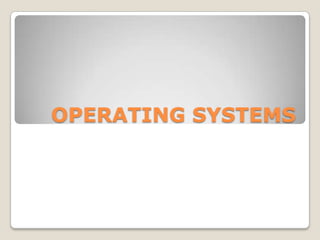
Operating Systems Explained
- 2. System Software System software includes all of the programs needed to keep a computer and its peripheral devices running smoothly. Two major categories of system software are: ◦ Operating systems (OS) ◦ System utilities
- 3. The Operating System (OS): The Computer’s Traffic Cop The operating system is a set of programs that perform certain basic functions with a specific type of hardware. The functions of the operating system are: ◦ Starting the computer ◦ Managing programs ◦ Managing memory ◦ Handling messages from input and output devices
- 4. Starting the Computer Booting – The process of loading or reloading the operating system into the computer’s memory. The booting processes are: ◦ Cold boot – Loads the OS when the power is turned on. ◦ Warm boot – Reloads the OS when the
- 5. The computer copies the kernel from the hard drive into the computer’s memory. ◦ The kernel: Is the central part of the operating system Starts all applications Manages devices and memory Resides in memory at all times Performs other essential functions Starting the Computer
- 6. The step-by-step booting process: I. The BIOS (basic input/output system) and setup program II. The power-on-self-test (POST) III. The operating system loads IV. System configuration V. System utilities loads VI. Users Authenticated Starting the Computer
- 7. Managing Programs Single-tasking systems run one application program at a time. Multitasking operating systems have the ability to run more than one application program at a time. ◦ Example What’s the difference between Time Sharing and Multitasking? ◦ Windows 3.1 vs. Windows 95 Multitasking is accomplished by: ◦ A foreground application – The active program or program in use ◦ One or more background applications – Inactive program(s) or program(s) not in use
- 8. Managing Memory Computers use memory to make processing more fluid. The operating system allocates memory areas for each running program; it keeps programs from interfering with each other. The operating system uses virtual memory as an extension of random access memory (RAM).
- 9. Managing Virtual Memory most recently hard disk transferred data or memory page program instructions swapped in Virtual memory management swap file page swapped least recently out used data or program instructions
- 10. Handling Input and Output Input and output devices generate interrupts, or signals, that tell the operating system that something has happened. ◦ Example: Keyboard, mouse, antivirus The OS provides interrupt handlers or mini- programs that begin when an interrupt occurs. Interrupt request (IRQ) lines handle the communications between input/output devices and the CPU. An IRQ conflict causes system instability when two devices try to use the same IRQ line.
- 11. Exploring Popular Operating Systems: A Guided Tour WINDOWS XP MAC OS UNIX MS-DOS LINUX
- 12. Microsoft Windows Windows XP (2001) Windows 3.x(1995) WindowsNT(1998) Windows2.0(1990-1992) ME (1985) 2000(2000) 98 (1987) 95 (1993) 1.0 (2000)
- 13. Windows XP Released in 2001 by Microsoft XP is short for “experience” Uses the same underlying code for all versions Replaces all previous versions of Windows Three versions: ◦ Windows XP Home Edition ◦ Windows XP
- 14. Windows NT Released in 1993 by Microsoft Designed for client/server systems Two components: ◦ Windows NT Workstation ◦ Windows NT Server Oriented to business needs Offers security, remote administration, directory services, and a Web
- 15. Windows CE Released in 1996 by Microsoft System used in PDAs or palmtops Runs simplified versions of Windows programs Data can be transferred to PCs Includes handwriting and voice recognition
- 16. MAC OS Created in 1984 First OS to use graphical user interface Easiest operating system for beginners A new version, Mac OS X, was released in 2000
- 17. MS-DOS Developed for IBM PCs in 1981 Uses command-line interface Use is diminishing To see: ◦ start ◦ Run ◦ cmd
- 18. Developed by AT&T in UNIX 1970s Included first preemptive multitasking system Developed concepts of file management and path names Facilitates client/server networking Widely used by corporations
- 19. Developed in Linux 1991 by UNIX Open-source code –Available for all to see and use Competes with Windows and MAC-OS Powerful and free Growing acceptance
